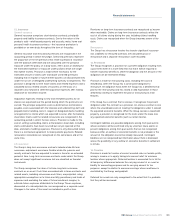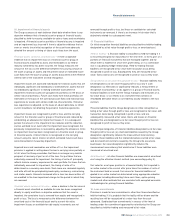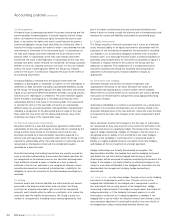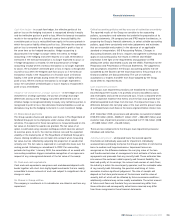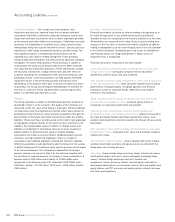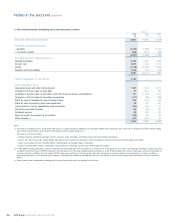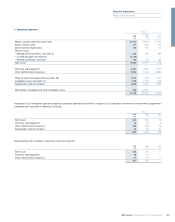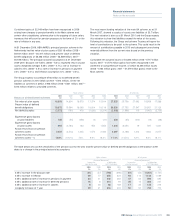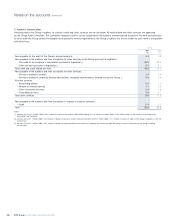RBS 2009 Annual Report Download - page 259
Download and view the complete annual report
Please find page 259 of the 2009 RBS annual report below. You can navigate through the pages in the report by either clicking on the pages listed below, or by using the keyword search tool below to find specific information within the annual report.
257RBS Group Annual Report and Accounts 2009
Fair value is the amount for which an asset could be exchanged, or a
liability settled, between knowledgeable, willing parties in an arm’s
length transaction. Fair values are determined from quoted prices in
active markets for identical financial assets or financial liabilities where
these are available. Fair value for a net open position in a financial asset
or financial liability in an active market is the current bid or offer price
times the number of units of the instrument held. Where a trading
portfolio contains both financial assets and financial liabilities which are
derivatives of the same underlying instrument, fair value is determined
by valuing the gross long and short positions at current mid market
prices, with an adjustment at portfolio level to the net open long or short
position to amend the valuation to bid or offer as appropriate. Where the
market for a financial instrument is not active, fair value is established
using a valuation technique. These valuation techniques involve a
degree of estimation, the extent of which depends on the instrument’s
complexity and the availability of market-based data. More details about
the Group’s valuation methodologies and the sensitivity to reasonably
possible alternative assumptions of the fair value of financial
instruments valued using techniques where at least one significant input
is unobservable are given in Note 11 on pages 270 to 291.
General insurance claims
The Group makes provision for the full cost of settling outstanding
claims arising from its general insurance business at the balance sheet
date, including claims estimated to have been incurred but not yet
reported at that date and claims handling expenses. General insurance
claims provisions amounted to £5,802 million at 31 December 2009
(2008 – £5,478 million; 2007 – £5,466 million).
Provisions are determined by management based on experience of
claims settled and on statistical models which require certain
assumptions to be made regarding the incidence, timing and amount of
claims and any specific factors such as adverse weather conditions. In
order to calculate the total provision required, the historical development
of claims is analysed using statistical methodology to extrapolate, within
acceptable probability parameters, the value of outstanding claims at
the balance sheet date. Also included in the estimation of outstanding
claims are other assumptions such as the inflationary factor used for
bodily injury claims which is based on historical trends and, therefore,
allows for some increase due to changes in common law and statute.
Costs for both direct and indirect claims handling expenses are also
included. Outward reinsurance recoveries are accounted for in the same
accounting period as the direct claims to which they relate. The
outstanding claims provision is based on information available to
management and the eventual outcome may vary from the original
assessment. Actual claims experience may differ from the historical
pattern on which the estimate is based and the cost of settling
individual claims may exceed that assumed.
Goodwill
The Group capitalises goodwill arising on the acquisition of businesses,
as discussed in accounting policy 6. The carrying value of goodwill as
at 31 December 2009 was £14,264 million (2008 – £15,562 million; 2007
– £42,953 million).
Goodwill is the excess of the cost of an acquired business over the fair
value of its net assets. The determination of the fair value of assets and
liabilities of businesses acquired requires the exercise of management
judgement; for example those financial assets and liabilities for which
there are no quoted prices, and those non-financial assets where
valuations reflect estimates of market conditions, such as property.
Different fair values would result in changes to the goodwill arising and
to the post-acquisition performance of the acquisition. Goodwill is not
amortised but is tested for impairment annually or more frequently if
events or changes in circumstances indicate that it might be impaired.
For the purposes of impairment testing, goodwill acquired in a business
combination is allocated to each of the Group’s cash-generating units or
groups of cash-generating units expected to benefit from the
combination. Goodwill impairment testing involves the comparison of
the carrying value of a cash-generating unit or group of cash-
generating units with its recoverable amount. The recoverable amount is
the higher of the unit’s fair value and its value in use. Value in use is the
present value of expected future cash flows from the cash-generating
unit or group of cash-generating units. Fair value is the amount
obtainable for the sale of the cash-generating unit in an arm’s length
transaction between knowledgeable, willing parties.
Impairment testing inherently involves a number of judgmental areas:
the preparation of cash flow forecasts for periods that are beyond the
normal requirements of management reporting; the assessment of the
discount rate appropriate to the business; estimation of the fair value of
cash-generating units; and the valuation of the separable assets of
each business whose goodwill is being reviewed. Sensitivity to changes
in assumptions is discussed in Note 17 on page 303.
Deferred tax
The Group makes provision for deferred tax on short-term and other
temporary differences where tax recognition occurs at a different time
from accounting recognition. Deferred tax assets of £7,039 million were
recognised as at 31 December 2009 (2008 – £7,082 million; 2007 –
£3,119 million).
The Group has recognised deferred tax assets in respect of losses,
principally in the UK, and short-term timing differences. Deferred tax
assets are recognised in respect of unused tax losses to the extent that
it is probable that there will be future taxable profits against which the
losses can be utilised. Business projections prepared for impairment
reviews (see Note 17) indicate that sufficient future taxable income will
be available against which to offset these recognised deferred tax
assets within eight years. The number of years into the future for which
forecast profits should be considered when assessing the recoverability
of a deferred tax asset is a matter of judgment. A period of eight years
is underpinned by the Group’s business projections, its history of
profitable operation and the continuing strength of its core business
franchises. The Group’s cumulative losses are principally attributable to
the recent unparalleled market conditions. Deferred tax assets of £2,163
million (2008 – £1,748 million; 2007 – £687 million) have not been
recognised in respect of tax losses carried forward in jurisdictions
where doubt exists over the availability of future taxable profits.
Financial statements






